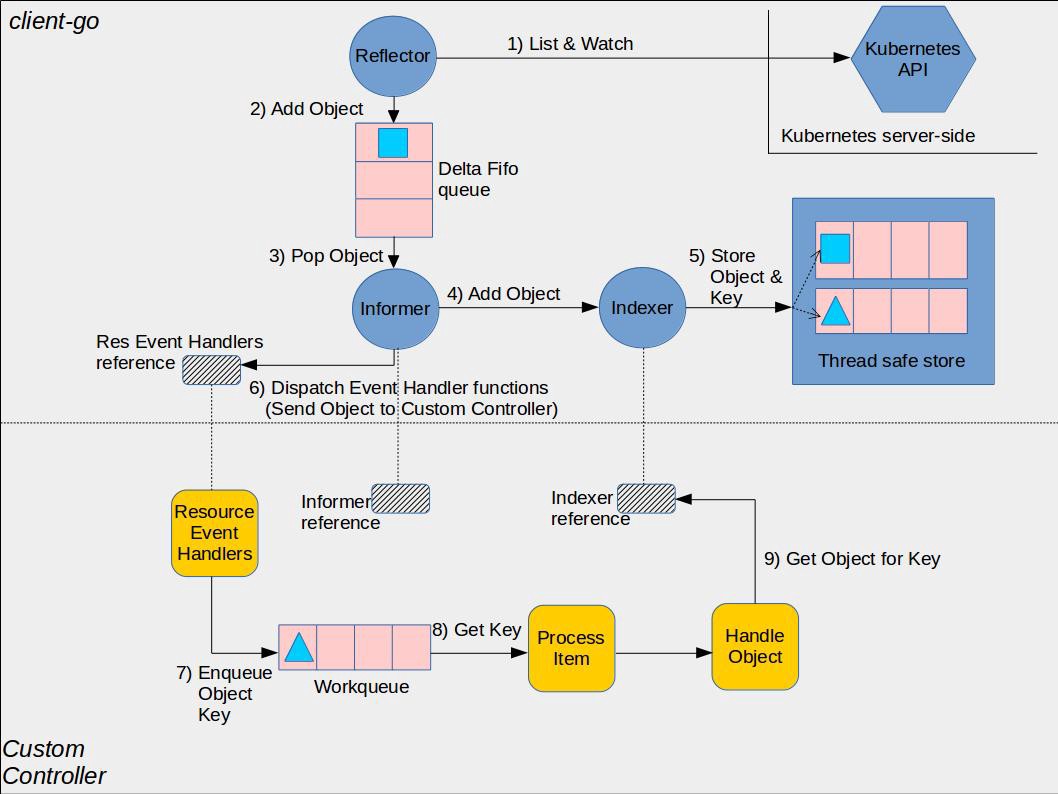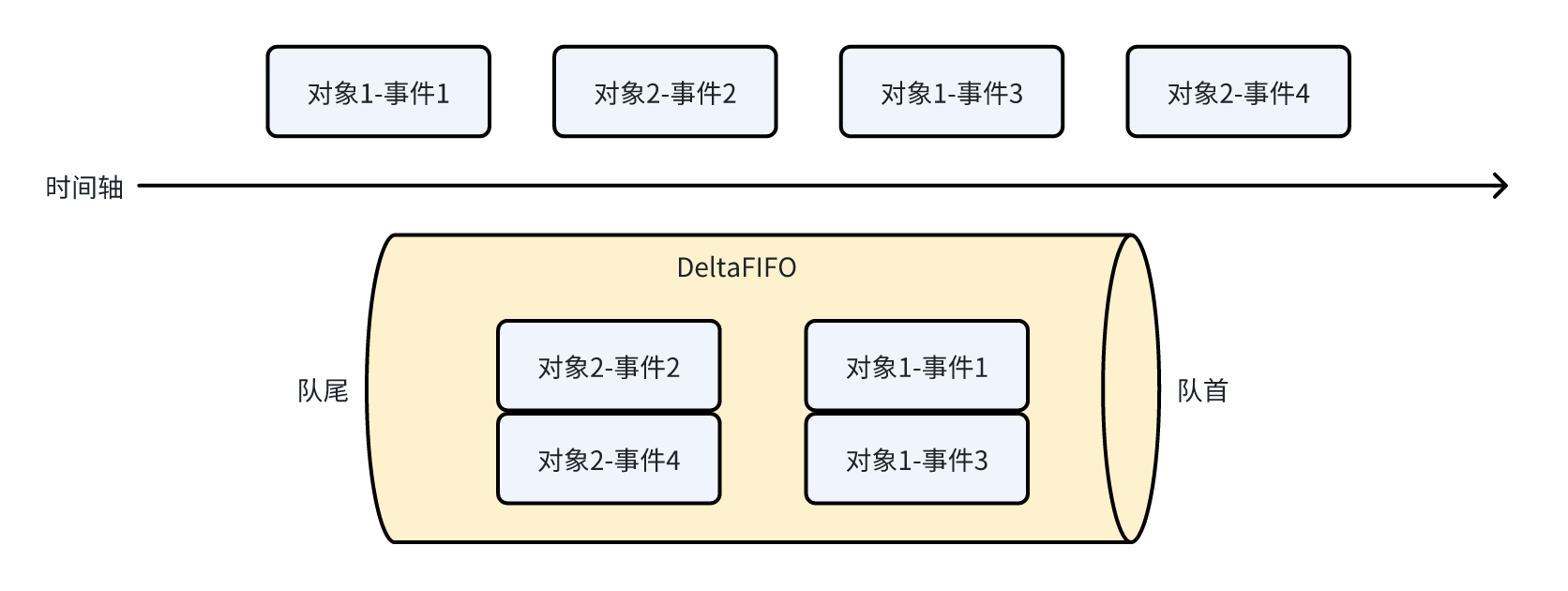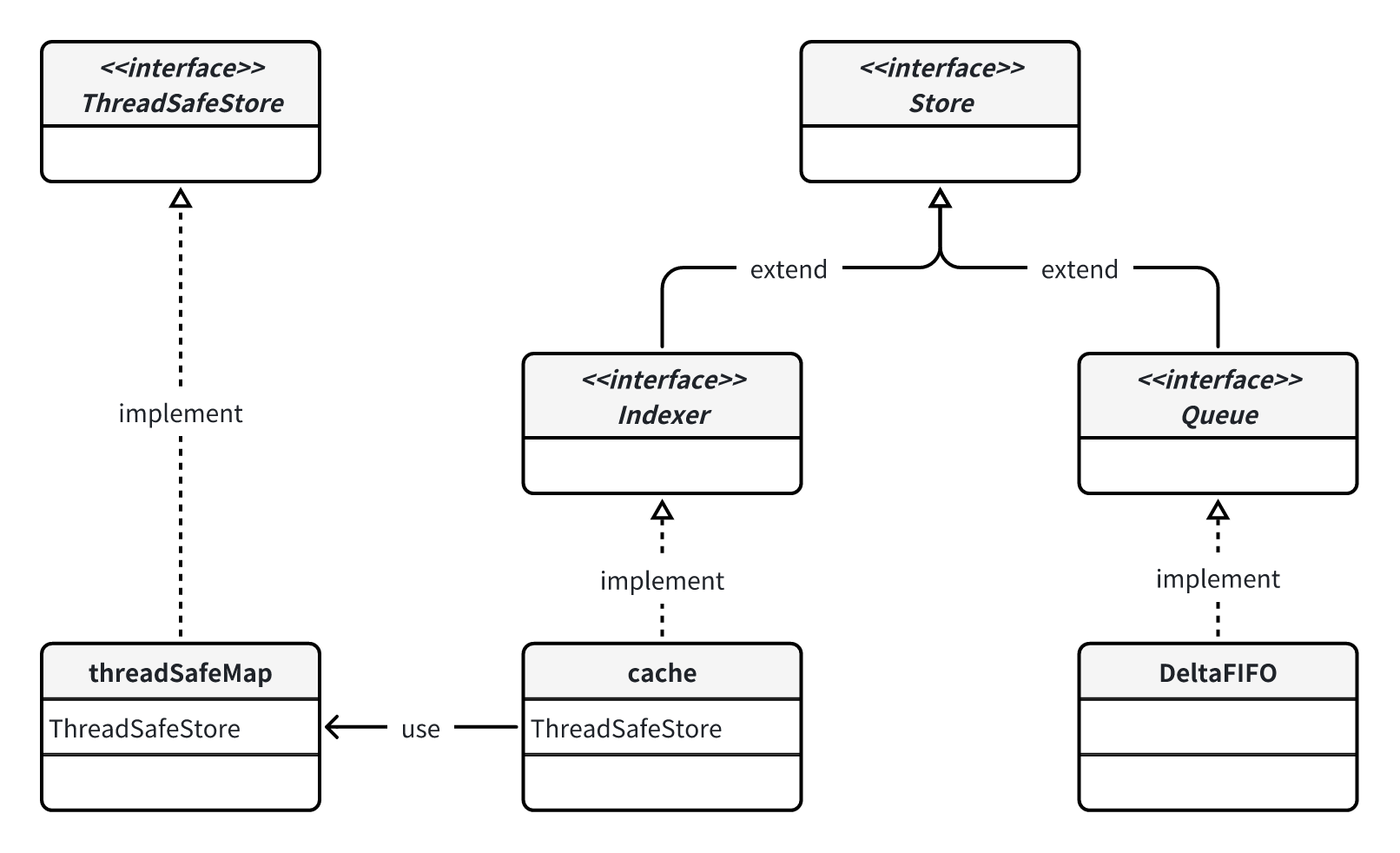Informer原理详解
原文博客:https://nosae.top
基于client-go@v0.31.13
informer介绍
informer是k8s客户端库提供的一个组件,用于 资源变更监听+资源缓存,用于高效感知k8s集群中的资源变化。
实际上它就是构建用户控制器Controller的基础,Controller一般是用来监听k8s中资源的状态更新然后我们去写业务逻辑代码对资源进行调谐,而所谓“监听”的功能就是informer实现的,即:
- Informer:负责监听和缓存资源变化
- Controller:负责消费这些变化,比如执行 Reconcile(调谐逻辑)
当然,informer可以单独拿来用,不与Controller强绑定,监听资源不一定就是做资源的调谐,还可以去做一些比如k8s资源实时可视化的功能,我这里只是拿informer+Controller来举例子,因为它比较常见。
informer架构

这张图清晰地表达了informer+controller所涉及到的组件以及它们的各自的组件边界,上半部分是client-go库内部实现informer的相关组件,下半部分是用户自定义Controller。我们下面都会围绕这张架构图来展开讨论。
informer核心组件包括:
- Reflector:负责监听API Server中的资源变化,将这些变化包装成事件发送到DeltaFIFO
- DeltaFIFO:先进先出的队列,队列元素是资源对象一段时间内的历史变更事件
- Indexer:存放全量的资源对象,并提供索引用于快速访问对象
- Informer:消费DeltaFIFO中的事件,并分发给ResourceEventHandler进行处理
以及用户代码部分的组件:
- ResourceEventHandler:用户注册的事件处理器,由informer进行调用。该回调函数的实现一般是拿到对象的key然后放进workqueue让worker协程去处理
- WorkQueue:用于解耦事件的接收与处理,用来做一些比如限流、出队策略等定制化操作
- ProcessItem:用于处理事件的函数,一般会持有Indexer的引用,通过key快速查询事件对应的资源对象
示例代码
talk is cheap,理解任何东西的原理之前首先得会用这个东西,因此先看看informer怎么在代码中使用,直接参考这篇文章,里面的示例代码涵盖了informer的前生今世,从原始http请求、到clientset、到informer再到sharedIndexInformer一步步是怎么演进的。
Reflector
Reflector负责监听API Server中的资源变化,具体来说,Reflector首先通过list获取apiserver中的全量数据并通过watch持续监听增量变化。
Reflector构造函数如下,创建一个Reflector必须指定一个ListerWatcher以及要监听的资源类型,由此可以看出,一个reflector只负责一种资源类型(比如只监听pod相关事件)
func NewReflectorWithOptions(lw ListerWatcher, expectedType interface{}, store Store, options ReflectorOptions) *Reflector
ListerWatcher是将Lister和Watcher两个接口合并成同一个接口(类似ReaderWriter那样),提供List和Watch的能力,具体实现是cache.ListWatch:
type ListWatch struct {
ListFunc ListFunc
WatchFunc WatchFunc
}
func (lw *ListWatch) List(options metav1.ListOptions) (runtime.Object, error) {
return lw.ListFunc(options)
}
func (lw *ListWatch) Watch(options metav1.ListOptions) (watch.Interface, error) {
return lw.WatchFunc(options)
}
cache.ListWatch具体的实现交给了ListFunc和WatchFunc,这两个函数由具体的资源类型来实现,下面看看pod的ListFunc和WatchFunc:
// client就是ClientSet
func NewFilteredPodInformer(client kubernetes.Interface, /* ... */) cache.SharedIndexInformer {
return cache.NewSharedIndexInformer(
&cache.ListWatch{
// List
ListFunc: func(options metav1.ListOptions) (runtime.Object, error) {
return client.CoreV1().Pods(namespace).List(context.TODO(), options)
},
// Watch
WatchFunc: func(options metav1.ListOptions) (watch.Interface, error) {
return client.CoreV1().Pods(namespace).Watch(context.TODO(), options)
},
},
// ...
)
}
由此可以发现,Reflector的本质是对client提供的List和Watch的进一步封装:
Reflector会开一个协程不断地去监听资源保持缓存与apiserver同步。为了兼容不同apiserver版本,可能会细分为两种不同的同步方式。
第一种是传统的ListWatch,通过分块/分页一次性list完成后关闭连接,再开新的watch长连接监听后续资源:
List(获取快照) → Watch(监听变化)
第二种是使用同一个watch连接,先发全量数据,继续使用同一条连接获取增量数据,即全程都使用流式传输的方式进行同步:
Watch(带 SendInitialEvents) → 收到所有 Added → Bookmark → 继续 Watch
相比第一种方式,流式list的好处在于这样可以降低apiserver的压力,详情可见proposal。下面是开始ListWatch的实现代码:
// ListWatch方法会获取全量资源对象以及持续监听后续变更
func (r *Reflector) ListAndWatch(stopCh <-chan struct{}) error {
klog.V(3).Infof("Listing and watching %v from %s", r.typeDescription, r.name)
var err error
var w watch.Interface
useWatchList := ptr.Deref(r.UseWatchList, false)
fallbackToList := !useWatchList
// stream方式list
if useWatchList {
w, err = r.watchList(stopCh)
if err != nil {
klog.Warningf("The watchlist request ended with an error, falling back to the standard LIST/WATCH semantics because making progress is better than deadlocking, err = %v", err)
fallbackToList = true
w = nil
}
}
// chunking方式list(fallback行为)
if fallbackToList {
err = r.list(stopCh)
if err != nil {
return err
}
}
// watch
return r.watchWithResync(w, stopCh)
}
下面把两种方式都介绍下,做个对比(代码省略了一些err处理)
流式list
func (r *Reflector) watchList(stopCh <-chan struct{}) (watch.Interface, error) {
// ...
for {
// ...
// 最后一次观察到的最大RV,该RV作为List和Watch的分界点,即小于该RV的对象属于全量数据,后续的对象都属于增量数据。初始时还没有观察到任何数据,因此RV="",表示使用当前集群最大RV
lastKnownRV := r.rewatchResourceVersion()
// 临时存储接收到的全量
temporaryStore = NewStore(DeletionHandlingMetaNamespaceKeyFunc)
options := metav1.ListOptions{
ResourceVersion: lastKnownRV,
AllowWatchBookmarks: true,
// 为了以watch的方式进行list,使用该参数指定watch在发送增量数据之前还要发送当前的全量数据,并且这些全量数据以Added事件表示
SendInitialEvents: pointer.Bool(true),
ResourceVersionMatch: metav1.ResourceVersionMatchNotOlderThan,
TimeoutSeconds: &timeoutSeconds,
}
// 开始流式list
w, err = r.listerWatcher.Watch(options)
// ...
// 处理接收的到的数据,并存入temporaryStore中
watchListBookmarkReceived, err := handleListWatch(start, w, temporaryStore, r.expectedType, r.expectedGVK, r.name, r.typeDescription,
func(rv string) { resourceVersion = rv },
r.clock, make(chan error), stopCh)
// ...
// 收到了Bookmark事件,意味着list已完成,否则进行下一次循环重试
if watchListBookmarkReceived {
break
}
}
// 使用Replace整体更新现有的缓存数据
if err := r.store.Replace(temporaryStore.List(), resourceVersion); err != nil {
return nil, fmt.Errorf("unable to sync watch-list result: %w", err)
}
// 更新观察到的最大的RV
r.setLastSyncResourceVersion(resourceVersion)
// 返回w,后续将使用同一个w进行watch
return w, nil
}
流式list的处理核心点在于对bookmark的处理,bookmark是list与watch之间的分割点。
分块list
不同于watch的持续监听事件流,list的行为是发一次请求,就返回一次数据
func (r *Reflector) list(stopCh <-chan struct{}) error {
// ...
go func() {
// 使用pager进行分页读取数据
pager := pager.New(pager.SimplePageFunc(func(opts metav1.ListOptions) (runtime.Object, error) {
return r.listerWatcher.List(opts)
}))
// 决定是否分页、分页的大小
switch {
case r.WatchListPageSize != 0:
pager.PageSize = r.WatchListPageSize
case r.paginatedResult:
case options.ResourceVersion != "" && options.ResourceVersion != "0":
pager.PageSize = 0
}
// 开始分块list
list, paginatedResult, err = pager.ListWithAlloc(context.Background(), options)
// ...
close(listCh)
}()
select {
// ...
case <-listCh:
}
// list已结束
// 此后的list调用一直启用分页(详解见下面第3点)
if options.ResourceVersion == "0" && paginatedResult {
r.paginatedResult = true
}
//...
// 使用Replace整体更新现有的缓存数据
if err := r.syncWith(items, resourceVersion); err != nil {
return fmt.Errorf("unable to sync list result: %v", err)
}
// ...
}
关于分页这块可以注意一下:
- 目前没有开放的API让用户设置分页大小,因此分页大小使用默认的大小500(每次最多返回500个对象)
- 不一定会进行分页,即可能会一次性返回所有对象。原因与设置的参数/API协议有关,不过多深究,想了解的话可以看3
- (TL;DR)首次list时将会使用RV="0",在数据一致性方面,这意味这返回的数据是非强一致性的,可能是旧一点的数据,但读取效率比较高;在数据源方面,将会优先从apiserver的watch cache中读取,watch cache会忽略分页,一次性返回所有数据,但如果watch cache没有启用,将会从etcd的follower或者leader读取。首次list结束之后,如果发现请求的RV="0"并且数据是以分页的方式返回的,说明watch cache没有启用,并且返回的对象比较多,已经超过了一页,那么将r.paginatedResult设置为true,以后的每次list都会使用分页的方式去拉数据。当RV等于某个精确值时,将始终从watch cache中拉数据,此时禁止分页。当RV=""时,将从etcd拉数据,此时需要使用分页。
分块list的处理核心点在于是否分页以及分页大小。
watch
watchList或list完了之后,就开始持续不断地watch了。在watch的同时,还会周期性地执行resync。resync用于将不在DeltaFIFO中的本地缓存对象,以Sync事件放到DeltaFIFO中通知上层去处理一下它们。至于为什么要resync,可以参考这个问答,以及这篇博客。
// watchWithResync runs watch with startResync in the background.
func (r *Reflector) watchWithResync(w watch.Interface, stopCh <-chan struct{}) error {
resyncerrc := make(chan error, 1)
cancelCh := make(chan struct{})
defer close(cancelCh)
// 定时resync
go r.startResync(stopCh, cancelCh, resyncerrc)
// watch
return r.watch(w, stopCh, resyncerrc)
}
resync不是我们的重点,来看下watch:
// watch simply starts a watch request with the server.
func (r *Reflector) watch(w watch.Interface, stopCh <-chan struct{}, resyncerrc chan error) error {
// ...
for {
// ...
// w==nil说明之前可能用的是分块list,主动发起Watch即可
if w == nil {
timeoutSeconds := int64(r.minWatchTimeout.Seconds() * (rand.Float64() + 1.0))
options := metav1.ListOptions{
ResourceVersion: r.LastSyncResourceVersion(),
TimeoutSeconds: &timeoutSeconds,
AllowWatchBookmarks: true,
}
w, err = r.listerWatcher.Watch(options)
// ...
}
// 持续watch,处理接收到的事件并直接存入store中
err = handleWatch(start, w, r.store, r.expectedType, r.expectedGVK, r.name, r.typeDescription, r.setLastSyncResourceVersion,
r.clock, resyncerrc, stopCh)
// ...
// 错误处理
// 可能会进行下一轮循环重新建立Watch,或者退出
}
}
DeltaFIFO
DeltaFIFO顾名思义是一个先进先出队列,队列元素是Deltas,一个Deltas包含多个Delta,Delta是对象事件:
type Deltas []Delta
type Delta struct {
Type DeltaType // 在对象上发生的事件,比如新增、删除等
Object interface{} // 对象
}
因此每次从队列pop元素时,是pop对象的在这段时间内发生的所有事件,用张图举个例子:

按照时间序,在两个对象上发生了四个事件,最终pop的时候是以对象为粒度进行pop,即先将对象1的两个事件作为整体pop,再到对象2。
DeltaFIFO的代码部分就没必要细看了,知道它在Pop元素的时候会处理被pop的元素即可,Pop简化一下大概如下:
func (f *DeltaFIFO) Pop(process PopProcessFunc) (interface{}, error) {
f.lock.Lock()
defer f.lock.Unlock()
for {
// 弹出队首元素(Deltas)
id := f.queue[0]
f.queue = f.queue[1:]
item, ok := f.items[id]
delete(f.items, id)
// 处理元素
err := process(item, isInInitialList)
// 将元素的所有权移交给外界
return item, err
}
}
Indexer
Indexer顾名思义是用来做索引的,索引什么呢?索引对象的key的。比如要获取namespace="default"的所有的pod,用Indexer就能快速得到这些对象的key集合(比如"pod1"、"pod2"这样的字符串集合),然后用这些key访问map获取对象。索引过程有点像倒排索引,即搜索属性为给定值的所有资源,比如namespace就是pod的属性。因此,索引的结构大概是这样的:
{
// 属性名称
"namespace": {
// 属性值 对应的资源
"default": ["pod1", "pod2"],
"kube-system": ["pod3"],
},
"nodeName": {
"node-1": ["pod1", "pod3"],
"node-2": ["pod2"],
},
}
实际上Indexer的本质还是一个存储了所有对象的本地缓存,只不过在这之基础上提供了索引功能。
(TL;DR: ...)
存储相关接口
上面说到的Indexer只是一个接口,可以看到Indexer是在Store接口基础上提供了索引的相关方法:
type Indexer interface {
Store
// Index returns the stored objects whose set of indexed values
// intersects the set of indexed values of the given object, for
// the named index
Index(indexName string, obj interface{}) ([]interface{}, error)
// IndexKeys returns the storage keys of the stored objects whose
// set of indexed values for the named index includes the given
// indexed value
IndexKeys(indexName, indexedValue string) ([]string, error)
// ListIndexFuncValues returns all the indexed values of the given index
ListIndexFuncValues(indexName string) []string
// ByIndex returns the stored objects whose set of indexed values
// for the named index includes the given indexed value
ByIndex(indexName, indexedValue string) ([]interface{}, error)
// GetIndexers return the indexers
GetIndexers() Indexers
// AddIndexers adds more indexers to this store. This supports adding indexes after the store already has items.
AddIndexers(newIndexers Indexers) error
}
Indexer的实现类是cache,cache又依赖于threadSafeMap提供索引功能。另外,DeltaFIFO所实现的Queue接口其实也是Store。
说到这里我觉得可以捋一下这些本地存储相关的各个接口的关系,因为看起来还挺乱的,类图如下:
Store提供了最基础的key-value存储能力,但是要注意这里key是通过value计算出来的,所以可以看到Store的许多方法都只传value不需要传key,比如插入一个对象时,key是通过keyFunc(obj)计算得到的:
Add(obj interface{}) error
需要注意的是,key对应的value实际上叫accumulator。accumulator可以被实现为简单的一个obj,即简单kv存储,比如图中的cache;accumulator也可以被实现为对象的集合,比如DeltaFIFO的实现中,accumulator就是一个Deltas。
Indexer和Queue则是在这个Store的基础上扩展了其它能力:Indexer提供了对key进行索引查找的能力,Queue提供了对象先进先出的能力。
最后再来看看结构体,我们关注的是cache和DeltaFIFO。cache缓存了所有的对象,缓存的是apiserver中的对象,并且cache实现了Indexer提供索引查找的能力。cache的实现很简单,因为具体的存储与索引实现放在了threadSafeMap中。DeltaFIFO虽然是Store,但目的不是存下所有对象,只是复用Store提供的方法,比如Add方法实际上类似Push的能力。
Controller(Informer)
我们在代码中使用cache.NewInformer或者cache.NewIndexInformer时,会发现返回的是一个Controller接口:
type Controller interface {
// Run does two things. One is to construct and run a Reflector
// to pump objects/notifications from the Config's ListerWatcher
// to the Config's Queue and possibly invoke the occasional Resync
// on that Queue. The other is to repeatedly Pop from the Queue
// and process with the Config's ProcessFunc. Both of these
// continue until `stopCh` is closed.
Run(stopCh <-chan struct{})
// HasSynced delegates to the Config's Queue
HasSynced() bool
// LastSyncResourceVersion delegates to the Reflector when there
// is one, otherwise returns the empty string
LastSyncResourceVersion() string
}
实际返回对象是controller对象:
// `*controller` implements Controller
type controller struct {
config Config
reflector *Reflector
reflectorMutex sync.RWMutex
clock clock.Clock
}
但是这里的Controller并不是指用户层面的那个控制器,对照上方的架构图来说,这里的Controller对应于架构图中的Informer组件,属于图中上方client-go的那层。因此,我觉得代码里的Controller应该命名为Informer猜对,同样地controller应该命名为informer。
controller的运行逻辑很简单,就是启动reflector然后运行processLoop不断地消费DeltaFIFO中的资源事件。
func (c *controller) Run(stopCh <-chan struct{}) {
// 创建reflector
r := NewReflectorWithOptions(/*...*/)
r.WatchListPageSize = c.config.WatchListPageSize
// ...
// 启动reflector
wg.StartWithChannel(stopCh, r.Run)
// 启动processLoop
wait.Until(c.processLoop, time.Second, stopCh)
wg.Wait()
}
func (c *controller) processLoop() {
for {
// 不断从DeltaFIFO中pop事件并处理
obj, err := c.config.Queue.Pop(PopProcessFunc(c.config.Process))
// ...
}
}
处理事件的函数是c.config.Process:
func newInformer(clientState Store, options InformerOptions) Controller {
// ...
cfg := &Config{
// ...
Process: func(obj interface{}, isInInitialList bool) error {
if deltas, ok := obj.(Deltas); ok {
// 直接交给processDeltas处理
return processDeltas(options.Handler, clientState, deltas, isInInitialList)
}
return errors.New("object given as Process argument is not Deltas")
},
}
return New(cfg)
}
具体由processDeltas去处理:
func processDeltas(
handler ResourceEventHandler,
clientState Store,
deltas Deltas,
isInInitialList bool,
) error {
// from oldest to newest
for _, d := range deltas {
obj := d.Object
switch d.Type {
case Sync, Replaced, Added, Updated:
if old, exists, err := clientState.Get(obj); err == nil && exists {
// update
// 更新Indexer
if err := clientState.Update(obj); err != nil {
return err
}
// 回调ResourceEventHandler
handler.OnUpdate(old, obj)
} else {
// add
// ...
}
case Deleted:
// delete
// ...
}
}
return nil
}
结合之前给出的示例代码,当我们去用cache.NewXXXInformer创建一个informer时,它处理事件的逻辑就是简单的两个步骤:
- 更新Indexer
- 回调用户注册的ResourceEventHandler
SharedIndexInformer
当我们一个程序里有多个地方需求监听同一种资源,如果每次都是cache.NewXXXInformer去创建新的Informer的话,这个动作的背后实际上在创建多个Reflector,即创建了多条与apiserver的连接,但监听的实际上是同一样东西,并且每个Informer中都缓存了一样的东西。如此一来既增加了apiserver的压力,又浪费了本地的内存。
因此client-go在Informer(即Controller接口)的基础上进一步封装,提供了SharedInformer接口,使得对同一种资源只需一次ListWatch、一个缓存,就能在程序任意地方去消费事件,从每个消费者的视角来看就好像自己独占一个Informer一样,也就是实现了所谓的fan-out,一次发送,多处消费。
其实要实现这个很简单,用伪代码表示大概是这样的:
// 从DeltaFIFO获取事件
item := DeltaFIFO.pop()
// 通知所有ResourceEventHandler
for _, handler := range handlers {
handler.handle(item)
}
在真正的代码实现上,sharedIndexInformer运用了设计模式中非常经典的代理模式:在不改动controller代码的前提下,sharedIndexInformer自身实现了ResourceEventHandler接口,将自己提供给controller,如此一来,之前controller处理事件第2步中的“回调用户注册的ResourceEventHandler”就变成了“回调sharedIndexInformer”。同时,sharedIndexInformer对外提供AddEventHandler(handler ResourceEventHandler)方法,在内部维护这些用户添加进来的ResourceEventHandler,将收到的事件逐一分发给这些ResourceHandler。
代码就没必要细看了,明白这个道理就行。
另外,SharedInformer其实就是SharedIndexInformer,因为索引功能几乎是一定会用得上的,所以client-go官方并不提供有"shared"但没有"index"的实现类。
WorkQueue
光看架构图的话,我一直不理解为什么要有WorkQueue这个东西,监听到事件之后直接去processItem不就可以了吗?但我们要知道,在k8s的设计理念中,控制器不是简单的事件回调,而是一个状态收敛循环,控制器会去访问apiserver对资源状态进行调谐,那么处理事件流时,自然就需要对事件进行去重、限流等操作,这就是WorkQueue所能提供的能力。
以示例代码使用到的workqueue为例:
workqueue.NewRateLimitingQueue(workqueue.DefaultControllerRateLimiter())
首先从名字可以看出,创建了一个具有限流功能的workqueue,并且传入了默认的限流器。这里默认限流器其实是两个限流器的组合,限流的力度取他俩中的最大值,即只要任意一个限流器觉得该 key 应该被延迟,就延迟:
- 指数退避限流器:对于单个元素,每重复Add一次,下次Get的时长就是上次Get的两倍
- 令牌桶限流器:对于所有元素,采用令牌桶限流(关于令牌桶限流算法自己chatgpt一下)
其中,指数退避限流器的意义是控制单个key的重试频率,因为某个key重试次数越多,说明失败率有点高,让它等久一点再同时。而令牌桶限流器的意义在于避免全局事件的突发流量,比如某时刻突然有很多不同的资源事件到来,肯定也得限流一下。因此他们的侧重点不同,组合起来能更有效地去做好限流。
以上我们介绍了WorkQueue限流的作用,还有解耦、缓冲、去重等,其实只是这些workqueue顺手的事。
workqueue看起来接口好像挺多挺乱的,可以像上面的存储相关接口一样,自己画个类图,就很容易理清了,在日后使用起来也更加得心应手。
总结
用operator那一套来举例:平时基于opeartor那一套去进行开发用户控制器进行集群资源调谐的时候,一般用kubebuilder去生成一些资源对象的深拷贝代码、Reconciler的脚手架代码等,虽然这些代码看起来并没涉及informer、indexer那些东西,但运行起来,当集群资源对象发生变更时,确实会及时回调我们的Reconcile调谐方法。在了解了informer这套机制后,不用想就知道是informer在底层起作用。
实际上,kubebuilder生成的代码里是用了controller-runtime这个库,它是对client-go进一步封装。这个库将informer、workqueue、processitem等封装起来,对外提供各种丰富的功能,让开发者更方便地去开发用户控制器。比如开发者只需要按照controller-runtime的规范,定义一个Reconciler并注册进去,把项目运行起来就能轻松对资源进行调谐了,十分省事。
参考
https://isekiro.com/categories/client-go/
https://github.com/kubernetes/sample-controller/blob/master/docs/controller-client-go.md
https://herbguo.gitbook.io/client-go/informer
https://github.com/cloudnativeto/sig-kubernetes/issues/11
https://gobomb.github.io/post/whats-resync-in-informer/
https://kubernetes.io/zh-cn/docs/reference/using-api/api-concepts/#resource-versions
https://www.zhaohuabing.com/post/2023-03-09-how-to-create-a-k8s-controller/


 浙公网安备 33010602011771号
浙公网安备 33010602011771号